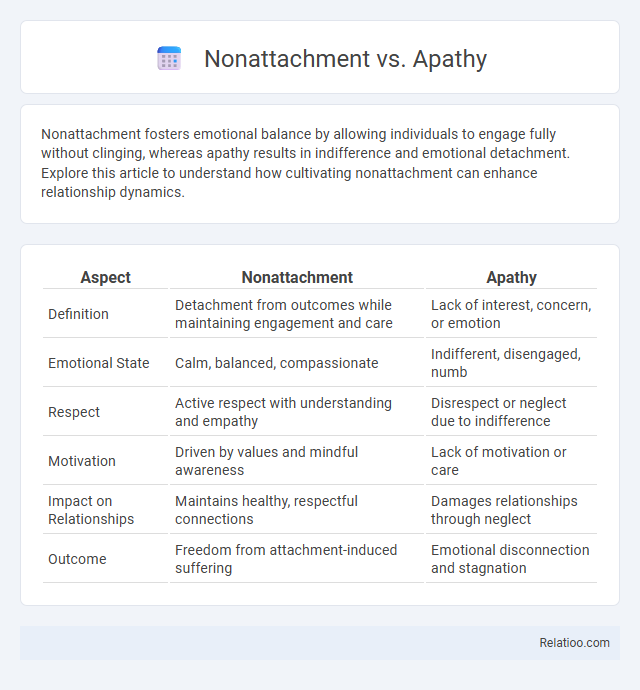Nonattachment fosters emotional balance by allowing individuals to engage fully without clinging, whereas apathy results in indifference and emotional detachment. Explore this article to understand how cultivating nonattachment can enhance relationship dynamics.
Table of Comparison
| Aspect | Nonattachment | Apathy |
|---|---|---|
| Definition | Detachment from outcomes while maintaining engagement and care | Lack of interest, concern, or emotion |
| Emotional State | Calm, balanced, compassionate | Indifferent, disengaged, numb |
| Respect | Active respect with understanding and empathy | Disrespect or neglect due to indifference |
| Motivation | Driven by values and mindful awareness | Lack of motivation or care |
| Impact on Relationships | Maintains healthy, respectful connections | Damages relationships through neglect |
| Outcome | Freedom from attachment-induced suffering | Emotional disconnection and stagnation |
Understanding Nonattachment and Apathy
Understanding nonattachment involves recognizing a state of emotional balance where you let go of clinging without losing interest or care. Apathy, by contrast, reflects a lack of feeling or concern, often leading to indifference and disengagement from life or relationships. True nonattachment cultivates mindful awareness and compassion, allowing you to experience life fully without becoming controlled by desires or fears.
Defining the Key Differences
Nonattachment involves a mindful release from cravings and aversions while maintaining engagement and compassion, distinguishing it from apathy, which is characterized by indifference and lack of emotional involvement. Unlike apathy, nonattachment fosters emotional resilience and balanced responses to life's challenges without suppressing feelings. Your understanding of these differences can enhance emotional intelligence and promote healthier relationships.
The Psychological Roots of Nonattachment
The psychological roots of nonattachment are deeply embedded in mindfulness and self-awareness, enabling individuals to recognize and release unhealthy emotional dependencies without disengaging from life. Unlike apathy, which stems from emotional numbness or indifference, nonattachment fosters a balanced perspective, promoting emotional resilience and well-being. Cultivating nonattachment involves understanding impermanence and reducing ego-driven desires, leading to greater mental clarity and freedom from suffering.
What Drives Apathy?
Apathy is primarily driven by emotional detachment and a lack of motivation to engage with experiences, often stemming from feelings of helplessness or disinterest. Unlike nonattachment, which involves mindful acceptance and a balanced emotional state without clinging, apathy reflects a passive disengagement and indifference toward outcomes. Understanding the distinction reveals that nonattachment is a conscious practice promoting mental clarity, while apathy results from emotional suppression and can hinder personal growth.
Emotional Outcomes of Each State
Nonattachment fosters emotional balance by promoting acceptance and reducing suffering without suppressing feelings, leading to resilience and inner peace. Apathy results in emotional numbness and detachment, often causing disconnection and diminished motivation or empathy. Nonattachment encourages mindful engagement with emotions, enabling clear perception and healthy responses, unlike apathy which stifles emotional growth and connection.
Nonattachment in Spiritual and Philosophical Traditions
Nonattachment in spiritual and philosophical traditions emphasizes a mindful disengagement from desires and outcomes, fostering inner peace without indifference to life's experiences. Unlike apathy, which denotes a lack of feeling or concern, nonattachment encourages active awareness and acceptance without emotional entanglement. Your practice of nonattachment cultivates freedom from suffering by reducing cravings and aversions, supporting a balanced and compassionate approach to existence.
The Consequences of Living with Apathy
Living with apathy results in emotional numbness, reduced motivation, and impaired relationships, undermining your overall well-being and personal growth. Unlike nonattachment, which encourages healthy detachment and mindfulness, apathy leads to disengagement and a lack of purpose. Recognizing the difference helps you foster emotional resilience without falling into indifference or neglect.
Practical Ways to Cultivate Nonattachment
Nonattachment involves recognizing and accepting impermanence without being emotionally entangled, distinguishing it from apathy, which reflects indifference or lack of concern. You can cultivate nonattachment through mindfulness meditation, conscious detachment from outcomes, and practicing gratitude to focus on the present moment rather than clinging to desires. These practical methods promote emotional resilience and mental clarity, enabling healthier relationships with thoughts and possessions.
Overcoming Apathy: Steps Toward Engagement
Overcoming apathy involves cultivating nonattachment by releasing emotional indifference without detaching from meaningful experiences. You can foster engagement by practicing mindful awareness, which encourages balanced emotional involvement without becoming overwhelmed. Developing clear personal values and setting intentional goals helps transform apathy into purposeful action and compassionate presence.
Choosing Nonattachment for a Balanced Life
Choosing nonattachment fosters emotional resilience by allowing individuals to engage deeply with experiences without clinging to outcomes, unlike apathy which detaches entirely and diminishes motivation. Nonattachment encourages mindful presence and acceptance, promoting mental clarity and reduced stress, whereas apathy often leads to disengagement and stagnation. Embracing nonattachment creates a balanced life by nurturing healthy relationships and inner peace without the burden of excessive desires or indifference.

Infographic: Nonattachment vs Apathy
 relatioo.com
relatioo.com